Harvesting firewood requires considerable effort: they need to be sawn, chopped, folded in to dry. Most of the energy goes into chopping wood. A wood splitter can facilitate and speed up the process. They are presented in sufficient quantities, but they cost solid money. At the same time, you can make the simplest wood splitter with your own hands from scrap metal - pipes, corners, etc. Everything will require literally several thousand - if there is no metal, it will have to be bought.
Mechanical wood splitters
If the volumes of firewood harvesting are small, a mechanical wood splitter can easily handle them. They are distinguished by their simplicity of design, the minimum number of complex nodes, and the fact that the costs are minimal, even if there are no suitable pieces of iron on the farm.
Do-it-yourself simple wood splitter: mechanics
The simplest mechanical wood splitter resembles a well crane. The design is one to one, only instead of a bucket a cutter and handles are fixed. The connection of the rack (racks) and the crossbar can be made the simplest - articulated. All you need is a good lubricant.
The principle of operation, probably everyone understands. The block of wood is placed on a stand, the lever is sharply pulled down, due to the force of inertia, the cutter gains significant strength and splits the block of wood. The process is repeated until logs of the required thickness are obtained.
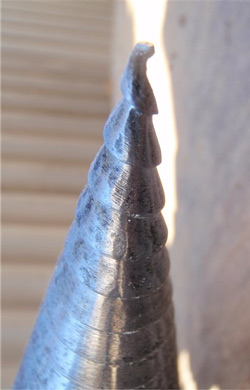
It is easy to assemble such a mechanical wood splitter with your own hands, and, literally, from what is - pipes, a corner of any size, even an ax can be used as a cutter. In addition, such a design can be made collapsible - so that it can be carried.
There are many cons. Chopping firewood requires a lot of effort. Moreover, more effort is applied to stop the course of the cleaver after the log has fallen apart. The second minus is that such a wood splitter occupies a solid area, because the longer the lever, the less effort must be applied. However, even such a primitive mechanical device greatly reduces the complexity of the process.
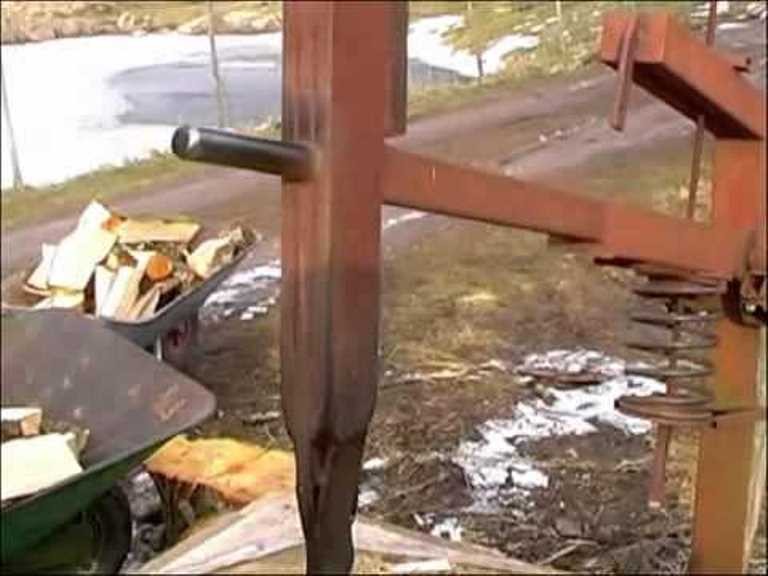
One option - the cleaver is welded to a square pipe filled with concrete
In this design, the cleaver must be heavy. Therefore, the blade itself is welded to an all-metal blank. A more affordable option is to weld it to a pipe (round or square) and fill it with concrete. Agree, to make such a wood splitter with your own hands is within the power of anyone who knows how to handle
Spring splitter
There is a modified design of a manual mechanical wood splitter, which, with smaller sizes, splits firewood better, requires less effort. In this model, the main working unit is a spring, which is fixed on the bed, and its upper part rests against the stationary crossbar, on which the cleaver is fixed.
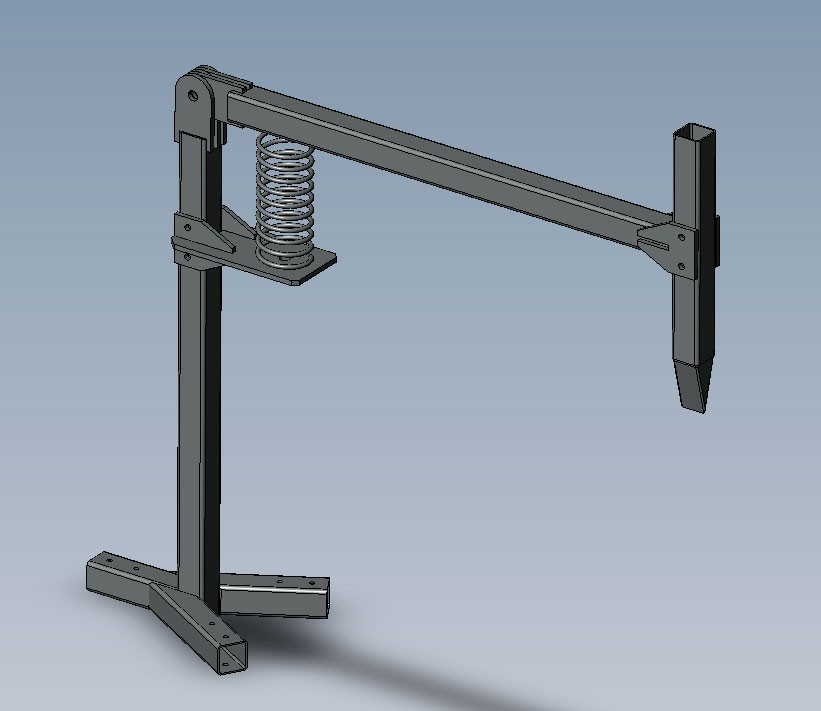
In this design, the main force - to hold the cleaver after the log has split - is assumed by the spring. Accordingly, the main thing is to choose a spring and an emphasis so that minimal efforts are applied, but they are sufficient to split even complex, knotty logs. The stop under the spring can be made movable. Then you can adjust the parameters for specific conditions. In reality, "reconfiguration" is required for a specific person. If one person will work with the tool, then you can do everything stationary, choosing the height empirically.
It is equally important to make a movable articulation of the frame and the lever on which the cleaver is fixed. The best option is bearings. They must be of high quality, preferably self-levelling.
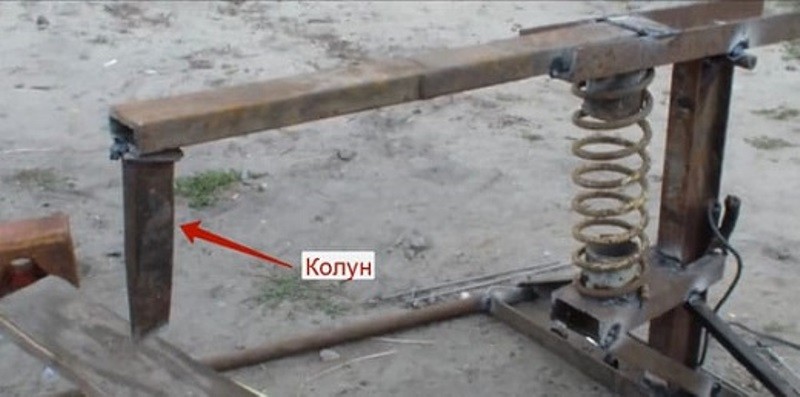
The minimum height of a homemade wood splitter is about 800 mm. But then you either have to work bending over, or install the machine on a table / bed. A more comfortable option that requires minimal effort - made to fit your height. Determine at what height it is convenient for you to stand a log, add the height of the log itself to this figure, you get the height of the bed. In this case, you will also have to bend over, but only when you install the chock on the stand, and not every time the cleaver is lowered.
You can work with one hand or come up with a clamp for installing logs (more safe)
To add mobility designs, a frame is welded, on one side of which wheels are fixed, and stops are welded on the second. Making such a wood splitter with your own hands is somewhat more difficult, but if there is a spring and bearings, this is such a difficult task.
Wood splitter inertial vertical
Another easy option for self-manufacturing. To make such a wood splitter with your own hands, you need two pipes of a larger and smaller diameter. You will also need a heavy plate - the base, and, in fact, the piercing part - the cutter / splitter.
The design is one of the simplest, little effort is required. A thick-walled pipe, or better, a pin, is fixed on a massive platform. The height is about a meter. This is the lead pipe. A cleaver moves freely along it, which is welded to the rings of a pipe of a slightly larger diameter than the leading pipe. He splits firewood as follows: lift up the cleaver and release it. You can give a little acceleration down. Due to the force of gravity, the log splits.
A heavy cleaver is the key to success in this model
But this mechanical wood splitter does not immediately split all logs. To increase its effectiveness, a weighting agent can be made on the cleaver. It can be "added" as needed. The second option is to hit the column with a hammer a couple of times. This method is good if the cutter is stuck in the wood. An alternative is to lift the block together up and down sharply. But it's easier to swing a hammer.
Wood splitters with electric drive
A manual wood splitter, of course, facilitates the preparation of firewood, but it still requires solid physical effort. Not as much as they are spent waving an ordinary cleaver, but still ... An electric motor helps to make efforts even smaller. Based on it, wood splitters of various designs are made. But making such a wood splitter with your own hands is more difficult. Here the device is more complex, and at least minimal knowledge of electricians is required, preferably.
Screw (conical)
One of the most common models is a cone or screw splitter. The difference between them is only in the absence / presence of a thread on the piercing element, which in this model is made in the form of a cone.
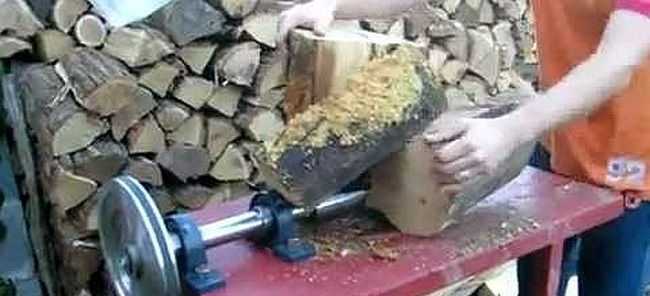
Blocks of wood split due to the fact that the cone rotated by the motor crashes into the wood, gradually tearing it apart. In large logs, the edges are first chipped off, then the middle is torn.
Cone and Thread Options
First, the cutting part was turned into a smooth cone. If you use a smooth cone, when working, you have to lean quite heavily on the block of wood so that the cylinder "bites" into the wood. The process is much easier if a thread is cut on its surface. In this case, the log is, as it were, screwed onto the screw, and then splits.
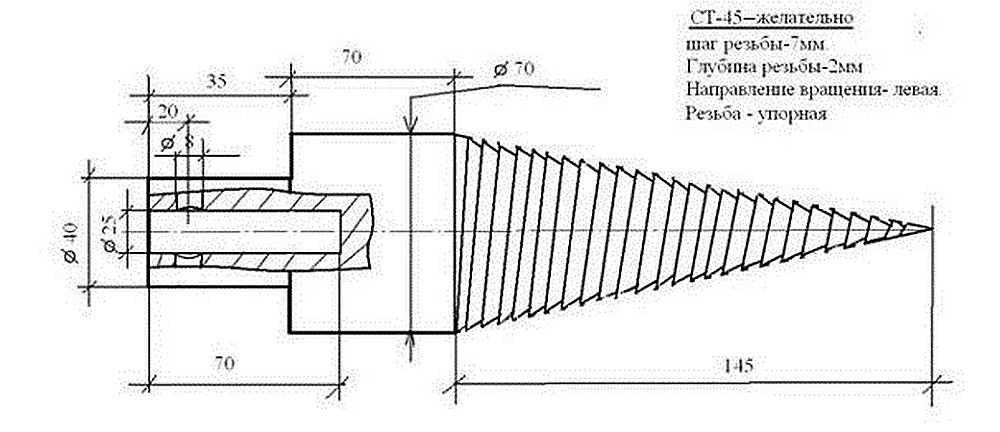
The main thing is to correctly make a cone with a thread. If you have a lathe and work experience, you can try to do it yourself. If not, you will have to order. The thread is made different, but the following parameters are recognized as optimal: pitch 7 mm, depth 3 mm (minimum - 2 mm). More important point- the depth of the seat on the motor gearbox - at least 70 mm.

If there is a cone with threaded threads, making this wood splitter with your own hands will not be difficult.
Electric motor and gearbox
We need an electric motor powerful enough (2 kW and above or 5-9 l / s), but with a low speed: 250-600 rpm. At 250 rpm and below, it punctures very slowly, and if the rpm is more than 500, it is dangerous to work, as it can tear the log out of your hands.
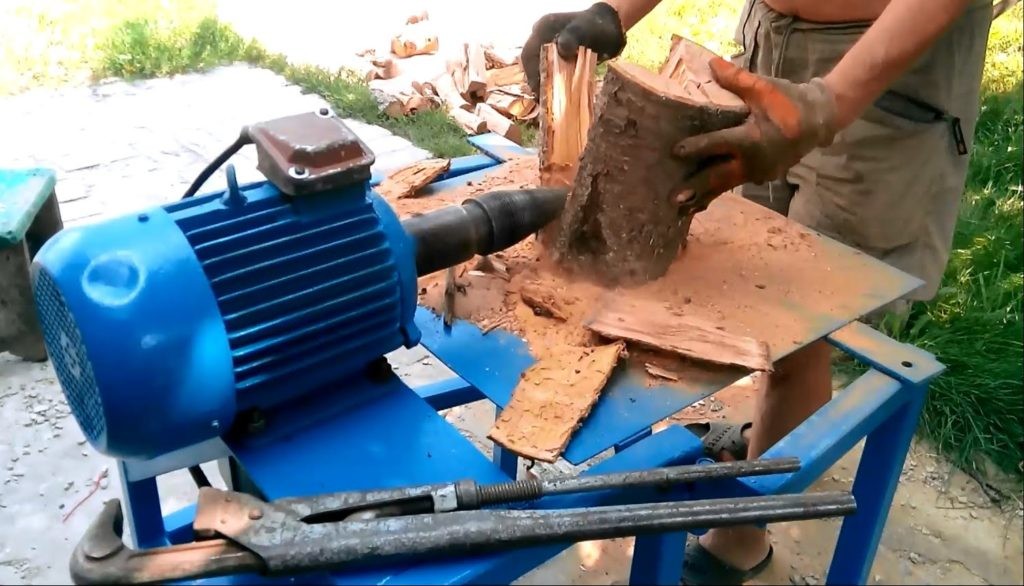
If you managed to find an engine with such parameters, you can put the spike (screw) made directly on the crankshaft (pictured above). If there are more revolutions, it is necessary to install a reduction gear or make a chain or belt drive to reduce the speed.
The ratio is calculated depending on the engine speed. For example, there is a 900 rpm engine. Having made a 1:2 gearbox, we get 450 rpm. Just the best option.
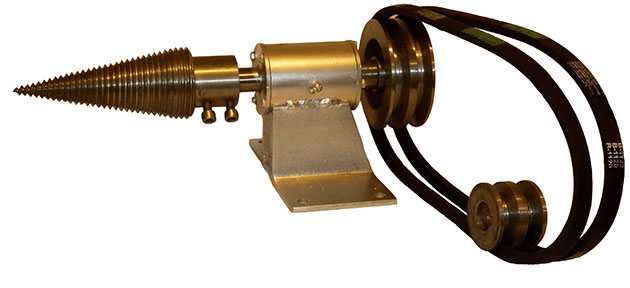
Gears can be belt or chain. Chains work many times louder, require constant strokes, and it usually costs more to grind sprockets with the required parameters. The belt drive is desirable double (as in the photo above). In this case, there will be less slippage.
Chain drive is noisier but more reliable "Extension" for the screw - to keep the workspace away from the motor or belts / chains
Where to place the motor
If the design provides for a gear, it is better to put the motor at the bottom, and fix the screw itself on the work surface. Choose the height of the work surface according to your height so that you do not have to work on an incline.
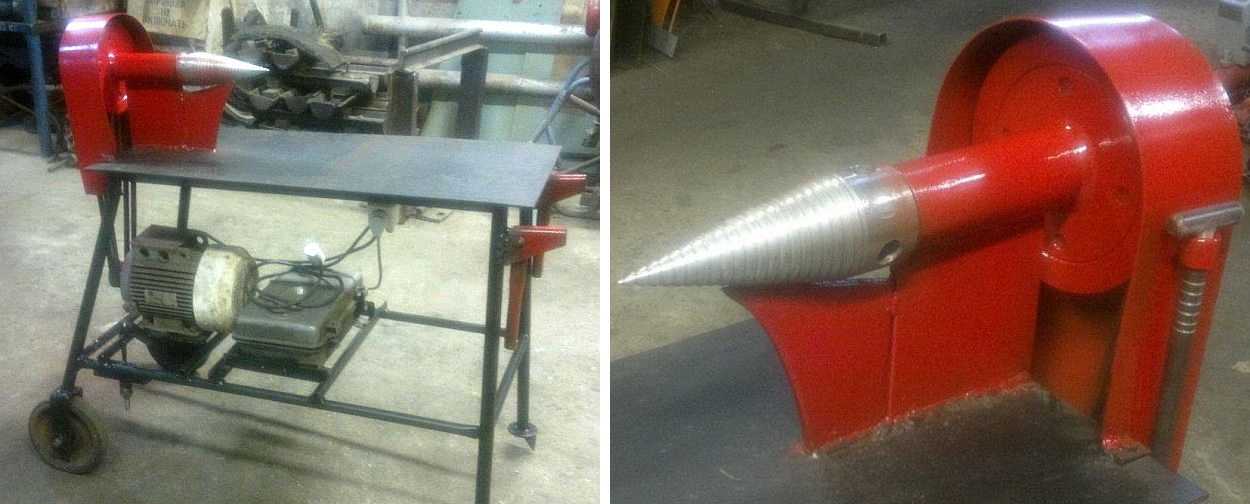
More secure model. Making such a wood splitter with your own hands will make your life much easier
There is also such a parameter as the height of the screw above the work surface. The gap from the table to the cylinder should be in the region of 8-20 cm. You should not place it higher - it can turn blocks of small diameter. The optimal distance is 8-12 cm. Even small logs do not turn.
Hydraulic wood splitter
The hydraulic wood splitter is the most powerful, but also the most complex and expensive to manufacture. In addition to the bed, motor and cutting blades, you need a hydraulic cylinder with sufficient power. They are not cheap. In addition, an oil tank and a pump are also needed.
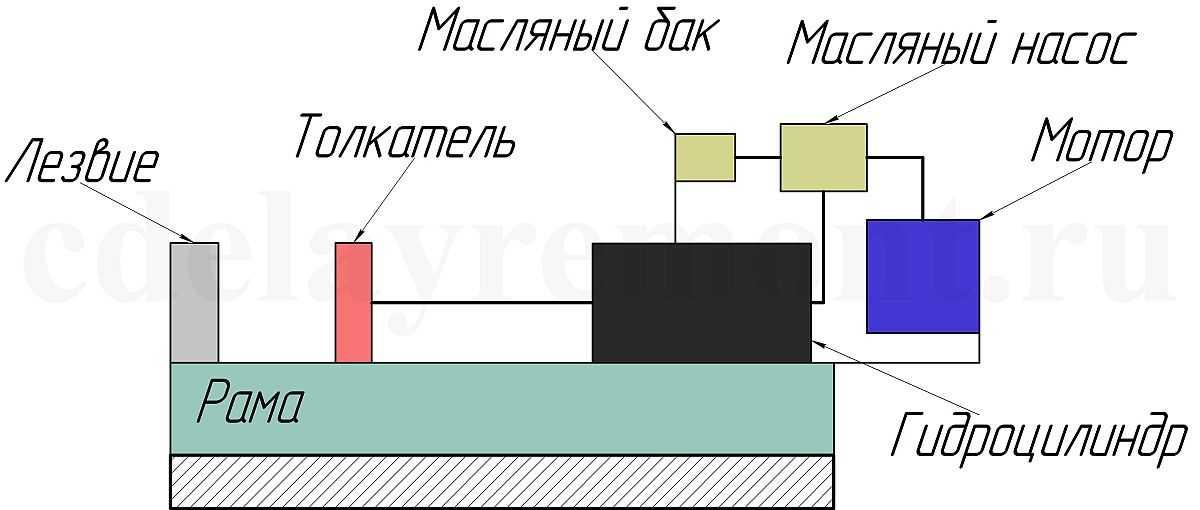
The hydraulic splitter for firewood develops solid efforts, therefore, in its manufacture, metal of considerable thickness is used - 6-10 mm, depending on the drive power. The developed effort is quite enough to break up the chock into 6-8 logs at a time. Because knives are made in the form of an "asterisk".
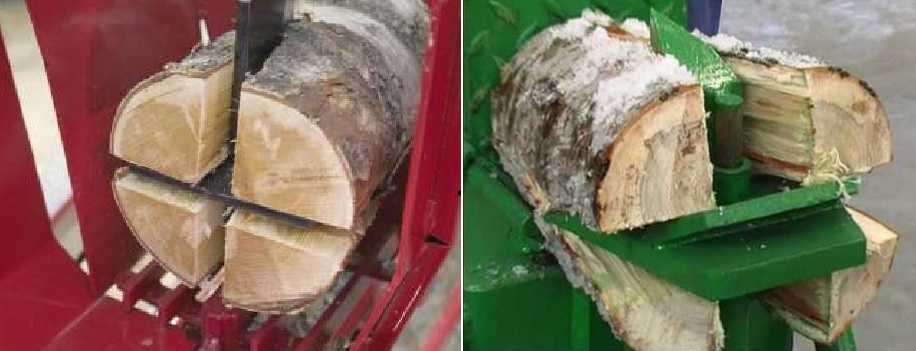
In the manufacture of knives, they are separated from each other by several centimeters. So that there is only one in operation. For example, first - horizontal, then - vertical, then - right and at the end - left. At the same time, reinforce each of the knives by welding reinforcing plates on the back. Steel is desirable to use hard, after sharpening it according to the same principle as on cleavers.
Related videos
- Types of homemade wood splitters
- Tools and materials needed to make a wood splitter with your own hands
In many rural areas of Russia, heating is carried out using firewood. Therefore, it is important to mechanize their felling. To do this, many craftsmen make a wood splitter with their own hands. Such equipment is sold on the Russian market, but many cannot afford its cost. How to make such a machine?
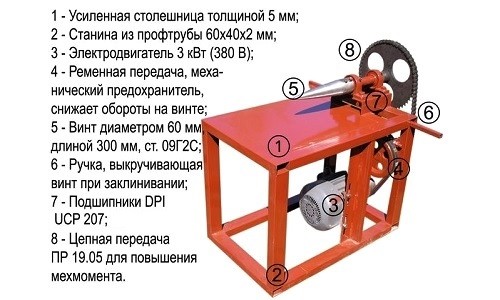
Figure 1. The device of a stationary screw wood splitter.
Types of homemade wood splitters
A household wood splitter can be mobile (on wheels) and stationary (Fig. 1). When developing such equipment, each person determines the type he needs. An electric motor or a gasoline engine is used as a drive. A household wood splitter powered by electric energy is usually powered by a single-phase network. But if it is not possible to use electricity, then the structure can be equipped with a gasoline engine with a power of at least 5 kW and an appropriate chain or belt drive. The working body of most home-made designs is a cone with a screw thread. For reliable operation of such a device, a persistent thread is used: it wears out less and enters the wood better.
Back to index
Screw wood splitter at home
Such a machine consists of the following parts:
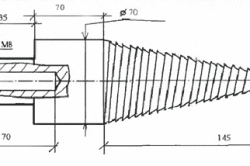
Figure 2. Drawing of a threaded screw cone.
- metal frame - bed;
- electric motor with belt drive;
- drive shaft block;
- screw cone with thread (Fig. 2).
To get started, you need to purchase metal squares and sheets on the construction market, pick up an engine. The working cone, pulleys for transmission and the shaft can be machined on a lathe or you can buy ready-made units from such equipment in a specialized store. Some craftsmen install a small cone on a puncher or drill with a power of up to 2 kW (550 rpm), but such a wood splitter with their own hands has low efficiency. The thickness of the material to be split does not exceed 11 cm. In order not to make a belt drive, a screw cone can be mounted on the shaft of a low-speed electric motor. Its technical data should be as follows:
- power - 2.5-5.5 kW;
- the number of revolutions of the output shaft is less than 500 rpm.
It is quite difficult to get such an electric motor, so it is best to use the belt drive option.
The ratio of the pulley diameters is chosen so as to reduce the number of revolutions of the motor output shaft to 350 rpm.
Having collected all the details, you can begin to assemble the wood splitter with your own hands. The technology of this process is as follows:
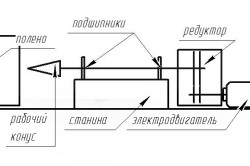
- A frame for the machine is welded from metal squares.
- From steel sheets 2-3 mm thick, rectangles of the desired size are cut out and welded to the frame so that it looks like a table with a shelf below.
- The electric motor is bolted to the lower level of the frame and a small diameter pulley is put on its shaft.
- The drive shaft block is assembled (Fig. 3): the bearings are inserted onto a steel bar turned to the required dimensions and fixed in sockets on the box. You can pick it up from old gearboxes or make it yourself from thick iron and weld it to the frame. When the assembly of this assembly is completed, it is checked for ease of rotation by hand and then a large diameter pulley is installed on the second end of the shaft.
- Put on the belts and check with your hand for ease of rotation. There should be no beats, otherwise you will have to spend time eliminating them.
- A screw cone is put on the output shaft and a power cable with a starter is connected to the electric motor.
- They check the wood splitter made with their own hands at work. To do this, with bare hands, carefully feed the log onto the working body and monitor the entry of the cone into the wood. With proper assembly, the machine starts to work immediately. If you need a mobile option, then small wheels are attached to the structure.
- To protect against corrosion, the machine must be painted.
The process of harvesting firewood has always been a laborious task. For large volumes of work, it is irrational to use a traditional cleaver - manual labor has always been ineffective. The first attempts to mechanize this process were made in the middle of the 19th century in the United States. The development of railway communications and a large number of steam locomotives required huge stocks of ready-made firewood. Steam models of wood splitters replaced the labor of hundreds of workers. The performance of modern wood splitters depends on the type of construction and the principle of operation.
How to choose a wood splitter
Sooner or later before every owner wood stove or a fireplace, the question arises - make a hydraulic wood splitter with your own hands or purchase a factory model. The latter are characterized by high performance and reliability. However, the high cost becomes a significant obstacle to the purchase. Therefore, in some cases, they prefer to make a household homemade wood splitter.
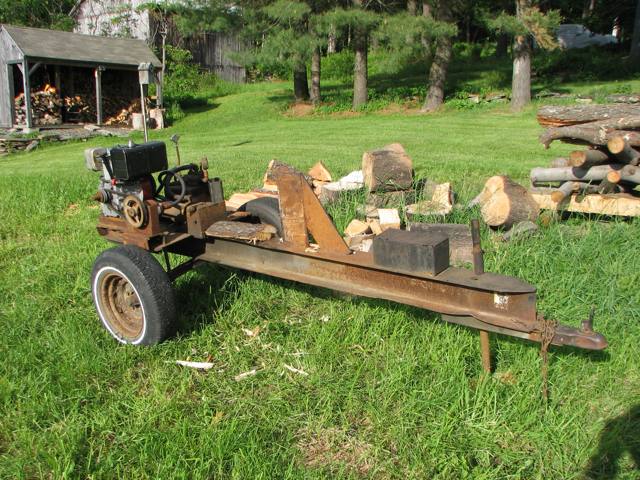
At the first stage, it is necessary to consider the main parameters of the device. They affect performance and performance.
- Location
In horizontal models, the logs are located on a special frame. There are two types of such machines. One of them is with a moving knife and fixation of the block of wood. According to another scheme, the log is directed to the cutting tool with the help of a feeder.
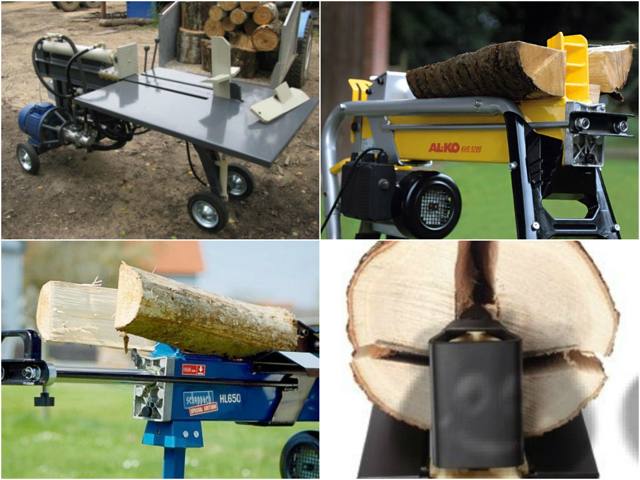
Vertical types are made with a fixed position of the workpiece. The knife acts on the surface of the log from above. Despite the high productivity in the process of work, it is often necessary to hold the workpiece with your hands. This is especially true for homemade models.
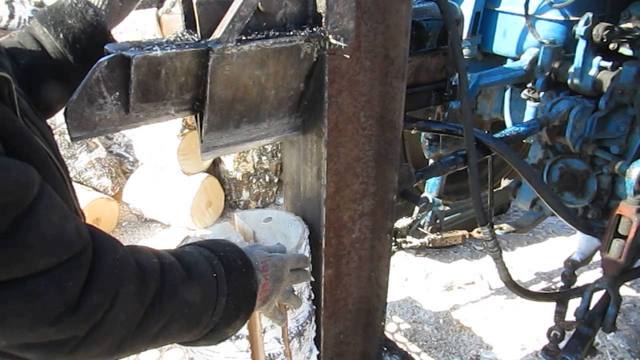
- type of drive
It is selected depending on the operating conditions. For fully autonomous models, it is recommended to use gasoline or diesel power units. Electric motors are used for stationary types. With small volumes of blanks, a mechanical wood splitter is used. Household models of such devices are characterized by reliability and simplicity of design.
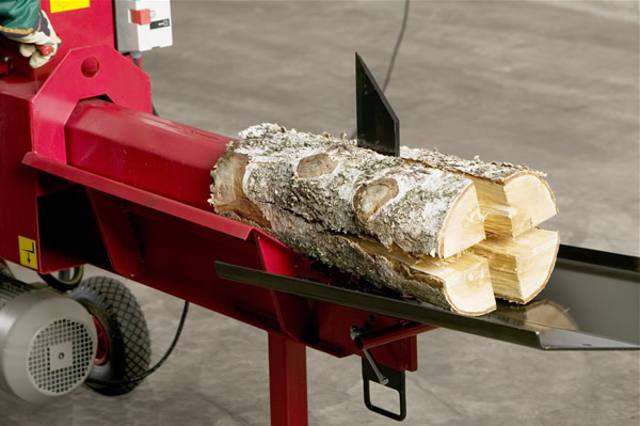
In the presence of tractor equipment, wood splitters driven by a power take-off shaft are used. Thanks to this, it is possible to split firewood of large diameter - up to 100 cm.
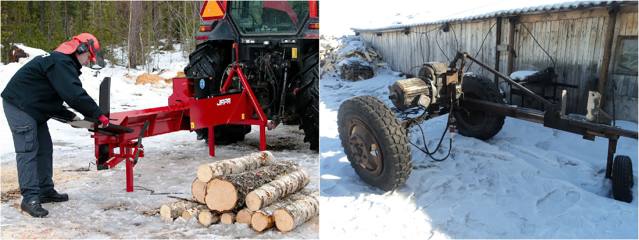
- Cleaver shape
You can use a traditional cone or a modified cruciform. The latter splits the log into 4 parts in one operation, which is very convenient. However, this requires a lot of effort. These types of splitters are used for hydraulic and mechanical types of wood splitters.
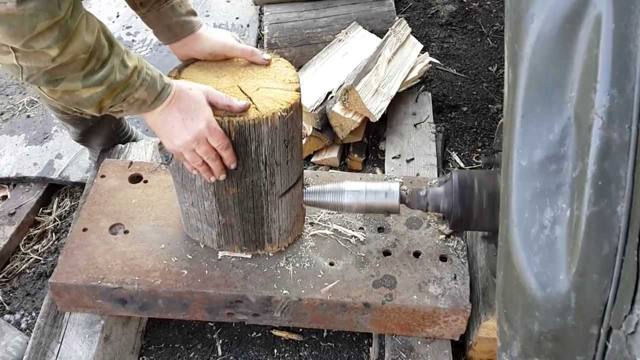
When using an electric drive or an internal combustion engine, it is optimal to use a screw or cone splitter. In addition to pressure, the deformation of the trunk along the longitudinal axis occurs due to rotary motion tip.
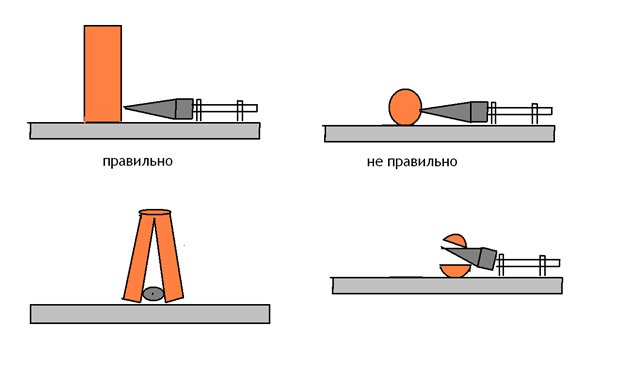
How to make a wood splitter so that the price is acceptable and the performance is optimal? To do this, it is necessary to consider various types of equipment and evaluate the possibility of self-manufacturing.
cone
This is one of the simplest types of equipment. In order to make a screw wood splitter, you need to buy: a threaded cone main part, a screw wood splitter. You can order production for your shaft and purchase a threaded splitting cone for a screw wood splitter: >>> >>> on the ODROVA.RU website with delivery throughout Russia, click to order<<<
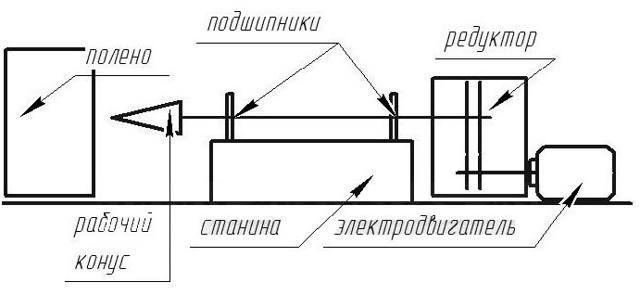
- Bed. The table is made of sheet metal with a thickness of 2 mm. It is best to use a steel profile as support legs. In the rear part of the structure, a mounting place is provided for mounting the gearbox.
- Power unit. It can be an internal combustion engine or an electric motor. Its power should be from 1.5 kW, rated voltage - 380 V. For normal operation, the number of revolutions varies from 400 to 600 rpm. It is located under the frame, providing additional stability to the structure.
- Gearbox with pin for mounting the working cone. It is necessary to regulate the speed of the power unit. To improve performance, a screw wood splitter is most often used, the scheme of which differs only in the design of the cone nozzle. On its surface there is a spiral notch, which greatly simplifies the destruction of the wood core.
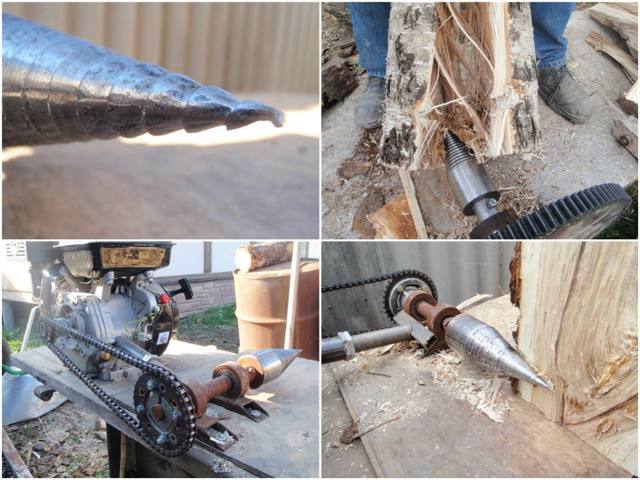
The advantage of such a machine lies in the affordable cost of individual components. Well suited for a private house or a small wood-burning boiler house. However, it has disadvantages - low productivity and manual supply of logs. Therefore, for large volumes of processing, a different design is used.
Hydraulic
For processing a large amount of wood, it is recommended to use hydraulic models of wood splitters. In these devices, the main power element is a cylinder, the rod of which extends under the action of fluid pressure inside. For this, a pump and an engine are provided. There are two ways to locate the cleaver - on the stem or in the design of the stop. When manufacturing, it is rational to use a drawing with the second scheme, since the hydraulic cleaver remains static, which increases the reliability of the entire device.
![]()
When choosing a particular model, you should pay attention to such parameters.
- Breaking force. Depends on engine power and cylinder size. Varies from 4 to 11 tone.
- The maximum size of the workpiece is from 50 to 200 cm.
- Engine power. Depends on its type: for an electric one, it can be 1.2-2 kW.
- The location of the log - horizontal or vertical.
This type of log splitter has a large capacity, so it can be used for both commercial and domestic purposes. It is important to consider the processing speed of workpieces and their maximum diameter.
Rack
These models use a gear train to drive the cutting bar. A cleaver is attached to it, which splits the log. A standard rack-and-pinion wood splitter consists of a motor, a belt reducer, a gear train and a splitter located on the cutting rail.
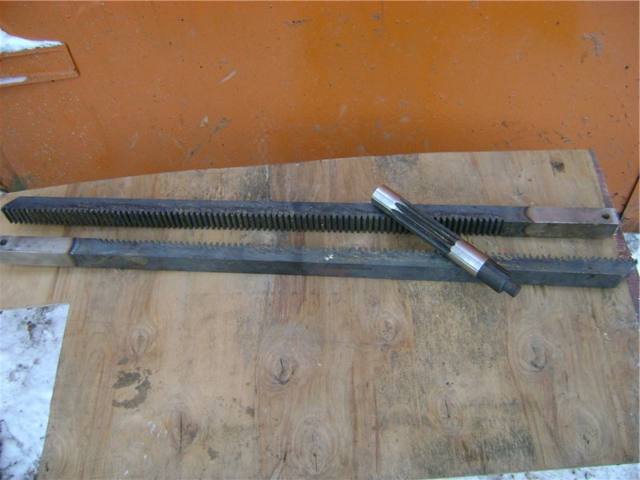
The log is located between the protective stop on the gearbox housing and the cleaver. When the handle is pressed, the gear is engaged, as a result of which the rack moves towards the casing, splitting the log. After removing the logs, the cleaver returns to its original position by the reverse movement of the handle.
This is one of the most efficient devices for home use. To reduce the cost of a home-made design, you can purchase a factory gear. Its cost is about 8.5 thousand rubles, then it is enough to make a table, install a gearbox with a gear on it, connecting it to an electric motor.
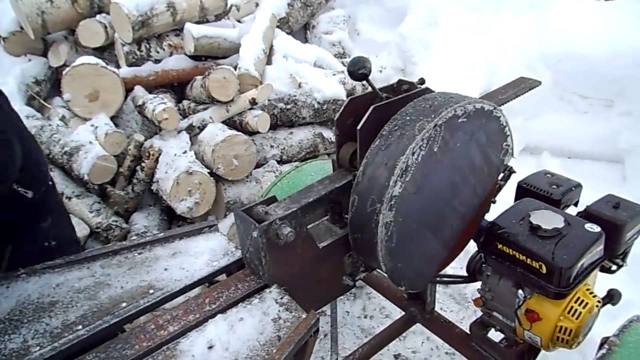
If it is necessary to choose a factory model of a rack-and-pinion wood splitter, you need to analyze its technical parameters:
- Breaking force.
- The maximum length of the workpiece. In most cases, it is 60 cm.
- Cleaver shape. In some models, it is possible to split the log into 6 parts in one pass of the rail.
Currently, there are many rack-and-pinion splitters on the market, differing in parameters, power unit power and dimensions of the processed logs. In addition, they have a different cost, which can significantly affect the choice.
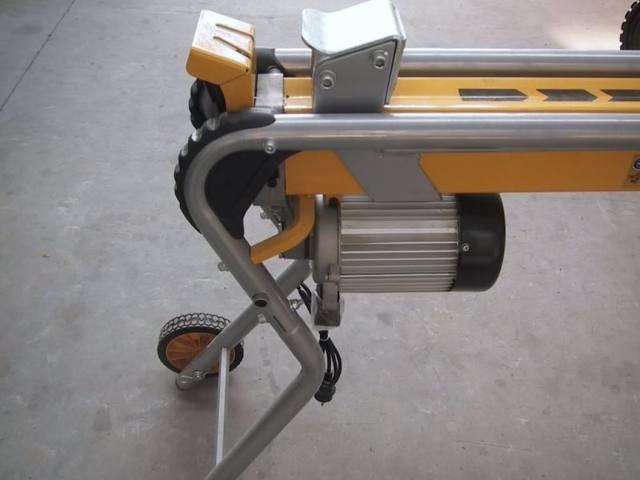
Prices
The cost of wood splitters depends on the type of construction, power and performance. Using the data from the pivot table, you can make an objective opinion about the price category of a particular model.
| Model name | wood splitter type | Rated power, kW | Breaking force, t. | Log dimensions, cm | Cost, thousand rubles | |
| Length | Diameter | |||||
| Engy Els-5030 | Hydraulic | 1,5 | 5,00 | 37 | 25 | 14500 |
| Texas PowerSplit | Hydraulic | 4,0 | 10,00 | 130 | 55 | 50600 |
| Sprint | Rack | 1,5 | 12,00 | 60 | 60 | 87000 |
Cone and screw wood splitters are not assembled. Most often, they purchase cones made of hardened steel grade ST45 at a price of 1800 rubles. The remaining components are selected from improvised materials.
Is it advisable to make a wood splitter yourself? If you have the necessary components (electric motor, table, gearbox) and minimal metal processing skills, then you should make a design for private use with your own hands. With a constant load, it is recommended to purchase factory models, as they have greater performance and differ from home-made ones in reliability and durability.
Wood splitter, of course, the unit is very useful in the economy. It is of particular interest to residents of villages and towns that heat their premises with wood-burning stoves. However, not everyone is ready to pay a round sum for it, especially since, if desired, this simple mechanism can be made by hand.
A simple do-it-yourself wood splitter
The simplest design is possessed by cone wood splitters, the basis of which is a threaded steel cone rotated by an electric motor. The most complex element of this design is the cone, which must be machined on a lathe ().
After the manufacture of the cone itself according to the presented drawing, a left-hand thrust thread is cut on it.
If it is not possible to machine the cone on the machine or order it, this part can be made independently with the help of a grinder. Moreover, there is no need to particularly accurately maintain the specified dimensions. In this case, it is simply necessary to initially put a metal grinder on the motor pulley, and having achieved its free rotation, evenly remove the metal.
 The finished cone is mounted on a shaft with bearings of the appropriate size, at the end of which a flange with an asterisk from a motorcycle wheel is installed. The threaded cone is fixed on the shaft with a pin or bolt, which makes it easy to remove it from the shaft and turn it out of the log in case of jamming.
The finished cone is mounted on a shaft with bearings of the appropriate size, at the end of which a flange with an asterisk from a motorcycle wheel is installed. The threaded cone is fixed on the shaft with a pin or bolt, which makes it easy to remove it from the shaft and turn it out of the log in case of jamming.
A cone removed from the shaft, stuck in a log, can be easily turned out of the wood using a gas wrench.
If the cone is fixed on the shaft tightly, in case of jamming, it becomes necessary to remove the drive chain, since it is not always possible to turn the motor shaft in the opposite direction.
Between the motor and the shaft, you can install a spacer of pipes and two nuts, with which the chain is tensioned. As shaft supports, cardan supports from the Zhiguli can be used.
If desired, the electric motor can be replaced with a gasoline unit from a walk-behind tractor with a power of at least 6 hp, although for cone wood splitters it is preferable to use electric motors with a power of at least 2-3 kW, with a rotation speed of at least 250 rpm.
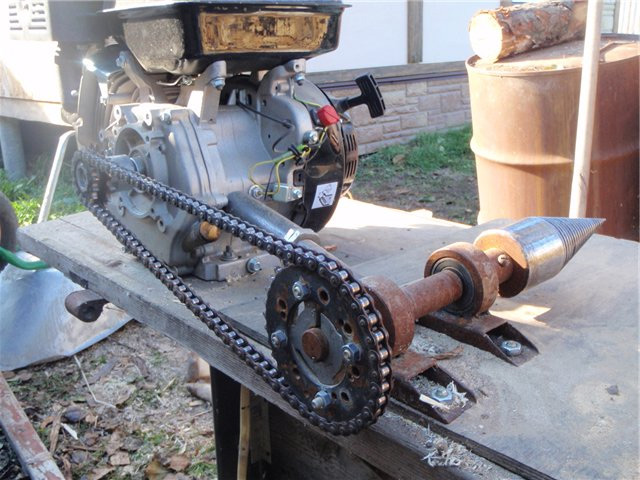
The principle of operation of a cone homemade wood splitter is extremely simple. During rotation, the cone, like a screw, is screwed into the wood, splitting it. When working with a wood splitter, you should be extremely careful and follow basic safety rules.
Nowadays it is difficult to find an area that would not be affected by mechanization and automation. Surprisingly, even such a classically conservative process as chopping firewood began to be mechanized, and the usual ax was replaced by wood splitters.
At present, a fairly wide range of mechanical splitters is already presented in this market segment, and in order to correctly select the unit you need, you should find out what this still unfamiliar machine is in general terms.
Wood splitter types
All currently produced wood splitters are divided into household and professional units.
Household wood splitters perform only the function of splitting wood. Professional wood splitters are a rather complex structure that feeds logs, trims them to the required length, splits and ejects finished logs. Of course, the cost, power, and performance of such machines cannot be compared with simple household units.
In the direction of feeding the split log, wood splitters are horizontal, vertical and mixed.
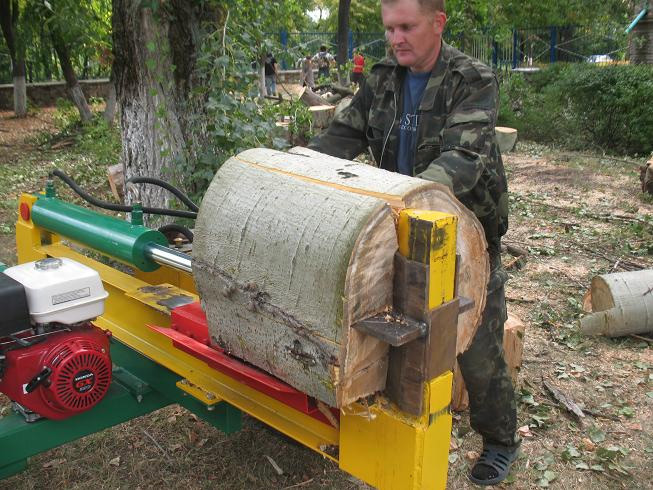 In horizontal type wood splitters, the block of wood is installed on a horizontal chute. In this case, depending on the design, either the pusher directs the log to the stabbing knife, or the knife moves along a special guide towards the log.
In horizontal type wood splitters, the block of wood is installed on a horizontal chute. In this case, depending on the design, either the pusher directs the log to the stabbing knife, or the knife moves along a special guide towards the log.
In vertical-type installations, the log is fed vertically, and a moving knife from above splits it. Mechanisms of this design are more productive, they occupy a smaller area, but they also have disadvantages. So, when working with vertical-type wood splitters, it is necessary to support the split logs with your hands, which requires strict adherence to safety rules.
Mixed type wood splitters combine the capabilities of the above units and are used exclusively in woodworking enterprises.
Depending on the power sources, wood splitters are divided into the following types:
- Units with electric motors. These are the simplest designs of wood splitters. The electric motor drives the hydraulic pump. Such wood splitters are easy to maintain and operate, they can be installed in almost any room. Wood splitters with electric motors do not require specialized maintenance and are most suitable for domestic use. The only mandatory requirement for their operation is the presence of a power source.
- Wood splitters with petrol or diesel internal combustion engines. These are quite powerful units, used mainly in logging. However, they are also suitable for working in summer cottages and garden plots.
- Tractor-drawn wood splitters. These units are connected to the tractor's hydraulic system or with a power take-off shaft. These are powerful professional units designed for operation in large timber processing complexes, farms, and industrial enterprises.
- Wood splitters with a combined drive source. Some models of log splitters equipped with electric motors or internal combustion engines are also adapted to work from a tractor drive.
Depending on the design of the mechanism for chopping wood, wood splitters are divided into the following types:
Also produced wood splitters differ from each other in the way of movement. As a rule, large, heavy units are produced in a stationary version. But the design of less heavy units provides for the presence of wheels that allow them to be easily transported.
Technical parameters of modern wood splitters
- Splitting power. This parameter indicates the required force produced by the block splitting unit. Household wood splitters have a capacity of 3 to 7 tons. For cone wood splitters, an important characteristic is the rotation speed of the threaded nozzle. The optimum rotation speed is 400-600 rpm.
- Working distance. This characteristic determines with what length of blocks the unit can work. For household woodcutters, as a rule, the size of logs does not exceed the size of the stove.
- The maximum diameter of the split log. Household units are capable of splitting logs with a diameter of 30 centimeters or more. At the same time, cone mechanisms can split stumps of almost any diameter.
- Piston stroke. This parameter specifies the distance traveled by the piston during an operation.
- Piston travel speed. The average piston speed when moving forward is 4 cm per second, when moving backward - 7.5 cm / sec.
- Motor power. As a rule, household wood splitters are equipped with electric motors with a power of 1500 to 2300 watts. The performance and efficiency of the unit largely depend on the power of the electric motor. Screw mechanisms are equipped with three-phase electric motors with a power of 3000 to 4000 watts.
- Dimensions. The sizes of household wood splitters vary depending on their models, power and manufacturer. Basically, these are quite compact units.
- Additional functions. The design of some models of hydraulic wood splitters allows the use of a 4-cutter nozzle, which significantly increases the performance of the mechanism. Some models include a special table that allows you to raise the working height of the wood splitter.
There are quite a few modifications of this device. At the moment, you can purchase the mentioned unit in a ready-made form, that is, produced at the factory, or you can make a wood splitter with your own hands.
Let's dive into the past
Such primitive types as axes, wedges, cleavers, sledgehammers and others are known to all as devices for splitting logs. However, it will be difficult for a woman or an elderly person to cope with such work, and the process itself can be dangerous. An ax that has fallen from an ax handle often causes serious injury to an inept woodcutter. And how pieces of metal flying off a wedge, or sharp chips, often injure the hands or face of a worker! In addition, often people who perform a lot of repetitive shock movements can suffer from diseases of the musculoskeletal system.
Your own master
In the manufacture of such a device there are no difficulties. To make such a machine, a minimum number of parts is required. The most complex elements can be called a frame or frame. However, it is worth considering that a wood splitter and a wood splitter are different concepts. The machine is capable of not only splitting wood, but also trimming it. This is more complex equipment, which is not needed so often on the farm. Therefore, we will dwell in detail on how to make a wood splitter with your own hands. All devices of this category can be divided into two groups: hydraulic and mechanical. Each of these types has distinctive features.
Mechanics
You can make a mechanical wood splitter with your own hands. It is based on a special screw in the form of a cone, screwed into the log, which leads to the "grinding" of the latter into several parts. If you decide to create such a unit, you should be prepared to overcome certain difficulties. First, you need the cone itself. It can be purchased at a large hardware store. By the way, despite the fact that this part is quite expensive, its purchase and assembly of the entire machine is several times cheaper than buying a new household appliance.
The wood splitter has another important mechanism - the engine, which is responsible for the operation of the unit. There are no restrictions here - you can use gasoline or it would be more correct to give preference to the second option, since it is much easier to find it, and the cost of electricity will be much lower than liquid fuel. However, it should be understood that the efficient operation of the wood splitter can only be ensured if the engine power is at least three kilowatts.
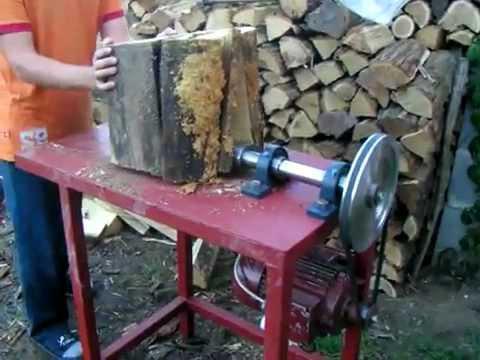
Device Features
Please note: it is unacceptable to install a cone on the shaft of such an engine, since this mechanism is characterized by a too high number of revolutions. In order for the cone to rotate at the optimum speed, it would be best to implement a chain drive. Choose the frame of the machine to your liking. Many equip the device with wheels, which allows you to move the device around the site, and not carry heavy logs to the wood splitter yourself. However, a fixed unit can be considered more successful, since it is more stable.
It is important to take care in advance that there is a power source nearby (this is the case with an electric drive). For a wood splitter, it is required to design a canopy that can protect it from precipitation, and the structure must be installed as close as possible to the woodpile. This will allow you not to deal with the constant drag and drop of material.
Option two - hydraulics
You may ask: how to make a hydraulic wood splitter with your own hands? Let's make a reservation right away that it is very problematic, almost impossible to design such a device on your own. After all, this will definitely require expensive equipment and the help of professionals. In addition, such units are not particularly popular in private households. And the cost of parts very often exceeds the amount that could be invested in the purchase of a finished device made at the factory. Someone just likes the principle of operation of such a device. In fact, the machine compresses firewood by splitting it. The biggest problem here is the hydraulic part. But if you still decide to make a hydraulic wood splitter with your own hands, you will need to purchase a cylinder with a pusher, an oil reservoir, a pump and a control unit. When assembling it, you will need the help of craftsmen, because in the absence of the necessary skills, it is unlikely that you will be able to do the work yourself.
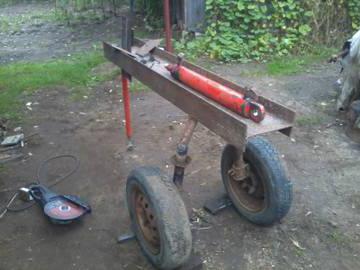
Option three
You can make a screw wood splitter with your own hands. This idea is quite original, but it consists in using a cone equipped with a thread for chopping firewood. If you are wondering how to make a wood splitter with your own hands, we note that this option is the most acceptable. Its design is quite strong, and in the process of assembling the screw unit there are no particular difficulties. It is best if the cone is professionally made on a lathe, but if this is not possible, you can use an ordinary grinder, through which most of the metal should be removed from the workpiece. First, the blank must be planted in the intended place of the cone, where it will rotate freely. Then you can easily 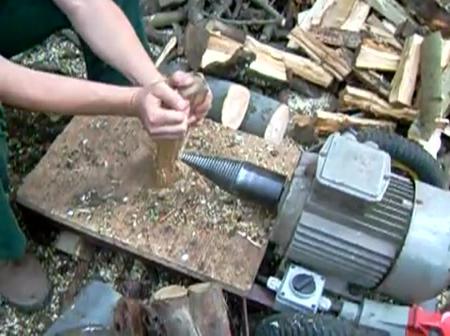
Making a wood splitter with your own hands is not so difficult. The device consists of several parts. It can be equipped with electric or however the first option will provide better working conditions. The threaded cone, as in the case of a mechanical unit, must not be mounted directly on the motor shaft. The chain drive will allow you to achieve the optimal speed for the device, which is approximately 400-600 rpm. The principle of operation of such a device is quite primitive. The cone rotates and is screwed into the log, which leads to its splitting.
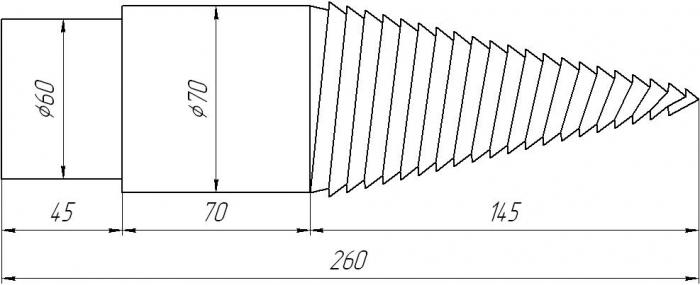
Option four
No less interesting is the rack-and-pinion wood splitter. It is also not very difficult to build it with your own hands. Note that the principle of operation of this mechanism differs from all others. The supply of chocks in this case is carried out along a special chute, and the cutting element moves towards them.
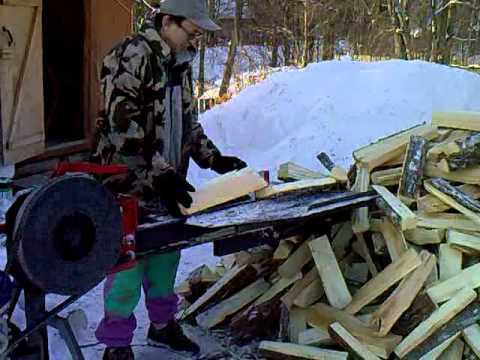
Advantages of wood splitters
Everyone understands that almost nothing is known about such equipment to an ordinary city dweller. However, it is enough to see photographs of such a unit as, say, a hydraulic wood splitter (made with your own hands or purchased in a store - it doesn’t matter) to understand how it works and what advantages it has. The main positive point in using wood splitters is that a person does not have to make much effort. There is almost no need to bend over, as the device can be easily adjusted to your height. The unit is always ready for use. You just need to turn on the machine, and it will start working, chopping as much firewood as you need. Of course, his work for a long time is stable. Well, anyone can figure out how it functions, since there is nothing complicated in its device at all. Provided that all safety rules regarding the electrical part are observed, as well as with proper protection of the machine from moisture and dampness, there should be no problems with the operation of the unit.




















